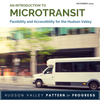HGAR and NYSAR Celebrate Legislative Wins, Prepare for 2026 Advocacy Push
With the full legislature and governor facing re-election in 2026, HGAR and NYSAR are already preparing for what could be a watershed year for housing policy.
“Reliable and flexible transit options, like microtransit, are essential. They connect people to jobs, education, health care and vital services.”

WHITE PLAINS—Hudson Valley Pattern for Progress recently released a report on the benefits and opportunities municipal Micro Transit programs can offer, particularly in more rural areas of the region that have little or in-flexible mass transit services.
The report entitled “An Introduction to Microtransit—Flexibility and Accessibility for the Hudson Valley” was funded by the Hudson Gateway Association of Realtors through a grant provided by the National Association of Realtors. The highlights of the report were presented in a virtual webinar sponsored by Hudson Valley Pattern and HGAR on March 13.
In introducing Adam Bosch, president and CEO of Hudson Valley Pattern for Progress, HGAR President Vlora Sejdi said microtransit services can be critical in certain sections of the Hudson Valley region.
“Reliable and flexible transit options, like microtransit, are essential. They connect people to jobs, education, health care and vital services,” Sejdi said. “These connections improve quality of life and make our communities more inviting and accessible for both current residents and newcomers alike.”
In its report, Pattern for Progress defines micrtransit as providing “on-demand service to riders. While details may differ between microtransit systems, they are generally characterized by a fleet of vehicles responding to ride requests within a defined service area. These vehicles are commonly smaller than typical fixed-route buses. Microtransit systems rely on technology to provide a user-friendly interface for requesting rides and ensure that routes and pickups are carried out efficiently in a shared vehicle. Using algorithms and a set of adjustable parameters, the system responds to ride requests as they are received through smartphone apps and telephone calls. The system adaptively plans routes, pickups, and drop-offs anywhere within the geographic service area.”

Pattern noted that microtransit is often used in areas that are difficult to serve with traditional fixed route systems, however, even where there is a robust public transit network “microtransit can serve an important complementary role by providing a more flexible service and filling gaps between other transit infrastructure,” the report stated.
Bosch, who noted that there has been an increase in public transit usage demand in the region, particularly in Dutchess County with an increase of 9,000 rides year-over-year and Ulster County, which implemented a free service, which saw a vibrant 100,000 ride increase last year.
“As we look at this and to serve more people through public transit, we are asking how do we serve more people who are in need by making the transit system more available to them, more flexible to meet the needs of where they are and where they need to go and in the course of doing that, are there ways that we can also make it more efficient?” Bosch said.
Pattern’s report noted that microtransit can have significant individual and community-wide benefits, such as reducing greenhouse gas emissions and traffic because fewer people are on the road in their own vehicles. “Public transit can also provide much-needed stability at a time when car ownership is expensive and many households are struggling financially. Dynamic transit systems can help these households get to work, to the doctor’s office and the grocery store, or other essential destinations. Recent Pattern studies have also underscored the growing need for public transit among senior citizens who are losing their ability to drive and, in turn, their timely access to a range of goods and services,” Pattern for Progress stated in the report.
The virtual program highlighted efforts by Suffolk County in employing micro transit and also featured Barbara Barosa, Commissioner of Planning for Putnam County, who highlighted a microtransit program to be put in place shortly in Putnam County. Putnam Area Rapid Transit will begin an on-demand microtransit service involving a pilot project launched in response to low use of a fixed-route bus route and to extend the area of service in the western part of the county.

Pattern’s report noted that Westchester has the highest percentage of the workforce with no access to a vehicle (8%), the longest average travel time to work (35 minutes), and the highest percentage of the workforce that commutes an hour or more (21%).
The counties within commuting distance to New York City have a higher percentage of the workforce that commutes for an hour or more. Interestingly, in every county in the region more than half of the workforce commutes to a job outside of their county of residence, revealing an opportunity for inter-county cooperation on public transit, Pattern stated.
The Pattern report chronicled a list of opportunities and benefits of implementing microtransit, along with some of its challenges and drawbacks.
Among the benefits and opportunities are:
The list of challenges and drawbacks to microtransit are:
Receive original business news about real estate and the REALTORS® who serve the lower Hudson Valley, delivered straight to your inbox. No credit card required.